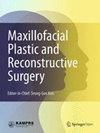Retrospective analysis on prognosis of oral cancer patients according to surgical approaches for effective cancer ablation: swing approach versus visor approach
IF 2.8
Q2 DENTISTRY, ORAL SURGERY & MEDICINE
Maxillofacial Plastic and Reconstructive Surgery
Pub Date : 2024-04-22
DOI:10.1186/s40902-024-00426-9
引用次数: 0
Abstract
For the surgical treatment of oral cancer, it is sometimes necessary to expand intraoral access within the oral cavity. The “swing approach” that involves lip splitting of the mandible and temporary mandibular osteotomy and the “visor approach” that does not split the lower lip and mandible are mainly used. This study analyzed postoperative outcomes such as complications, recurrence rate, and survival rate by these two approaches. The goal of this study is to evaluate the surgical outcomes of patients using these two approaches, to propose effective perioperative management for oral cancer surgery, and to compare the prognosis of oral cancer patients. From 2005 to 2020, 29 patients who underwent surgery at the Department of Oral and Maxillofacial Surgery of Pusan National University Dental Hospital for oral cancer lesions occurred in the mandible, floor of mouth, and tongue were selected for the study. Based on the surgical approach used, a chart review was conducted on various prognostic clinical factors such as the patients’ sex and age, primary site, TNM stage, histopathologic grade, recurrence and metastasis, postoperative survival rate, adjuvant chemo-radiation therapy, satisfaction with aesthetics/function/swallowing, length of hospital stay, tracheostomy and its duration, and neck dissection and its type. Statistical analysis was conducted using SPSS 25.0 (SPSS Inc., Chicago, IL) through Fisher’s exact t-test. There was no statistically significant difference between two groups in terms of clinical and pathological findings, such as survival rate, the need for adjuvant therapies, and the local recurrence rate. Although better outcomes were observed in terms of function, aesthetics, and postoperative complications in the group with visor approach, there was still no statistically significant difference between two groups. However, the duration of hospital stay was shorter in the visor approach group. There was no statistically significant difference in clinical prognostic factors between the swing approach and the visor approach. Therefore, when choosing between the two approaches for the ablation of oral cancer, it is considered to select the surgical priority approach that can be easy access based on the size and location of the lesion. The visor approach had advantages of aesthetics and healing period.根据有效消融癌症的手术方法对口腔癌患者预后的回顾性分析:摆动法与面罩法
在口腔癌的手术治疗中,有时需要在口腔内扩大口腔内入路。目前主要采用的是下颌骨唇裂和临时下颌骨截骨的 "摆动法 "和不切开下唇和下颌骨的 "面罩法"。本研究分析了这两种方法的术后效果,如并发症、复发率和存活率。本研究的目的是评估使用这两种方法的患者的手术效果,为口腔癌手术提出有效的围手术期管理建议,并比较口腔癌患者的预后。研究选取了 2005 年至 2020 年期间在釜山大学牙科医院口腔颌面外科接受手术治疗的 29 名下颌骨、口底和舌头口腔癌病变患者。根据所采用的手术方法,对患者的性别和年龄、原发部位、TNM 分期、组织病理学分级、复发和转移、术后生存率、辅助化疗和放疗、对美观/功能/吞咽的满意度、住院时间、气管造口术及其持续时间、颈部切除术及其类型等各种预后临床因素进行了病历回顾。统计分析使用 SPSS 25.0 (SPSS Inc., Chicago, IL) 通过费雪精确 t 检验进行。两组患者的临床和病理结果,如存活率、辅助治疗需求和局部复发率,在统计学上无明显差异。虽然在功能、美观度和术后并发症方面,面罩法组的疗效更好,但两组之间的差异仍无统计学意义。不过,遮盖器入路组的住院时间较短。在临床预后因素方面,摇摆入路法和遮盖器入路法的差异无统计学意义。因此,在选择两种方法消融口腔癌时,应根据病灶的大小和位置,优先选择易于进入的手术方法。遮盖器方法在美观和愈合期方面具有优势。
本文章由计算机程序翻译,如有差异,请以英文原文为准。
求助全文
约1分钟内获得全文
求助全文
来源期刊

Maxillofacial Plastic and Reconstructive Surgery
DENTISTRY, ORAL SURGERY & MEDICINE-
CiteScore
4.30
自引率
13.00%
发文量
37
审稿时长
13 weeks
 求助内容:
求助内容: 应助结果提醒方式:
应助结果提醒方式:


